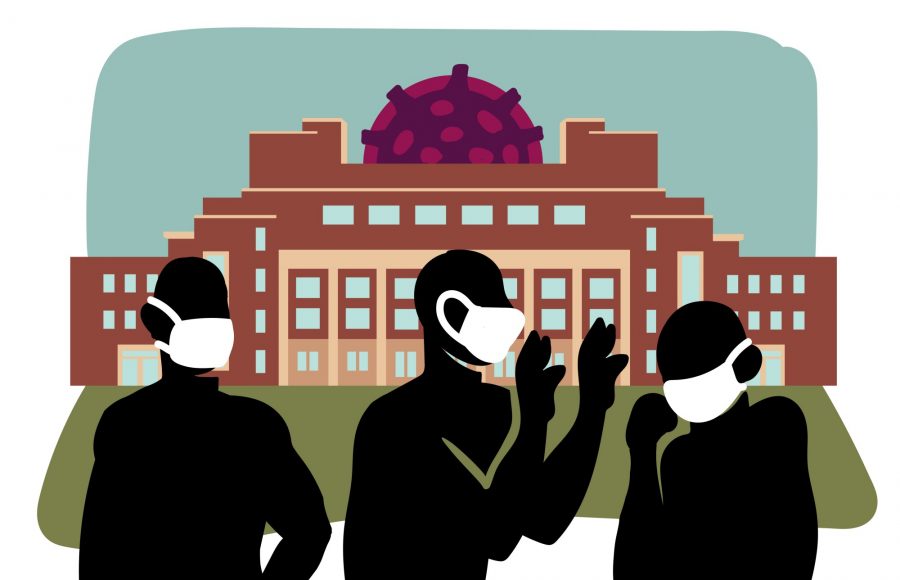Minnesota universities and colleges are taking different approaches to COVID-19 policies and mask mandates as case numbers and transmission rates have decreased over the last few months.
Many universities loosened their masking requirements in the past month with recent changes from the Centers for Disease Control and Prevention (CDC) in how the risk level of COVID-19 is measured. The University of Minnesota lifted masking requirements March 21 in some indoor spaces on campus, but masks are still required in classrooms, public transportation and healthcare settings.
Other schools are taking a different approach, with some lifting masking requirements completely. All included universities said they followed guidance from the CDC and the Minnesota Department of Health (MDH) when making decisions.
The city of Minneapolis also lifted its mask mandate for public indoor spaces, including restaurants, schools and recreational facilities, on Feb. 24.
University of Minnesota
In a campus-wide email sent March 11, University President Joan Gabel announced masks would no longer be required in dining settings, common areas, office spaces, sporting events or entertainment venues.
In addition to guidance from the CDC and the MDH, Gabel said the University decided to change their policy after monitoring COVID-19 cases, transmission rates and hospitalizations.
“We continue to work with our community stakeholders on this measured approach to shifting mask decision-making to individuals, and you should anticipate further updates,” University spokesperson Jake Ricker said in an email.
Ricker said the University is continuing to require masks in classrooms and instructional settings because they tend to be “higher density” than other settings.
“With key data points trending downward and most of Minnesota entering the ‘low’ risk category – in addition to the University community’s high rate of vaccination – the decision was made to no longer require masks in many University settings,” Ricker said.
Minnesota State University Mankato
On March 7, Minnesota State University Mankato (MSU) announced masks were no longer required in indoor spaces on campus, including in classrooms.
David Jones, MSU vice president of student affairs and enrollment management, said the decision was made after the Minnesota State Chancellor announced schools located in counties with low to moderate COVID-19 transmission levels could lift their mask mandate.
“That was the benchmark,” Jones said. “So any county that was in the moderate or high was required to have masking.”
Masking is still required in locations that offer healthcare services, including their dental health clinic and student health center.
Although masking requirements have been lifted, many people at MSU are choosing to wear masks for their own health and safety, Jones said.
Jones said he is excited to be in a stage of the pandemic where there can be higher levels of communication and MSU’s facilities can open to the general public again.
“[MSU’s] behavior and their choices allowed us to get to the point we are now where we are hopefully moving beyond in going to be able to return to so many of the activities with full participation like we did before,” Jones said.
Saint Cloud State University
Masking requirements shifted for Saint Cloud State University (SCSU) beginning March 15. As of this date, masks were no longer required on campus, apart from in healthcare facilities. SCSU’s proof of vaccination requirement was also lifted on campus.
Steve South, SCSU interim assistant vice president of safety and risk management, said they decided to lift masking requirements due to cases declining on campus and in the surrounding community.
SCSU has not reported any COVID-19 cases on campus since the beginning of March, South said.
“We have an on-site testing facility on campus and that allows us to monitor data coming in and as to how many people are testing positive on campus,” South said. “Those case numbers have plummeted.”
Brent Nielsen, medical director of the SCSU medical clinic, said that although they collaborate and meet with other Minnesota universities, these outside responses did not influence SCSU’s masking decisions.
Nielsen said SCSU’s location in a part of the state with lower COVID-19 transmission rates was an important factor.
“COVID decision-making has to be very dynamic because things have changed throughout this whole pandemic,” Nielsen said. “Right now we have a change that is positive where we have enough evidence that we don’t need to be doing masking, but that could certainly change.”
University of Saint Thomas
Similar to the University of Minnesota’s approach, the University of St. Thomas (UST) announced masking requirements were lifted in various indoor spaces, but still required in classrooms, the campus shuttle and the Center for Well-Being on Feb. 26.
“Our case numbers on campus are low, they’ve been trending downward and we’ve seen no evidence of cases in labs or classrooms,” UST spokesperson Andy Ybarra said.
In addition to guidance from the CDC and MDH, Ybarra said high vaccination rates, local public guidance and declining cases factored into their decision.
Although it was not a priority in their decision making process, UST monitored and followed the University of Minnesota’s COVID-19 response as well, Ybarra said.
All four universities are still encouraging their campus populations to get vaccinated and receive the booster in addition to staying home when feeling sick to help stop the spread of COVID-19, according to announcements from each college.
“Having lived through this for the last two years, I think too many people focus on was a decision right or wrong,” Nielsen said. “You don’t really know, in a thing like COVID, what’s the right decision all the time but we try to use all the best data you can to make a good decision.”



















